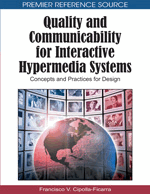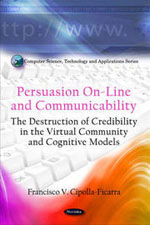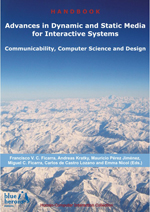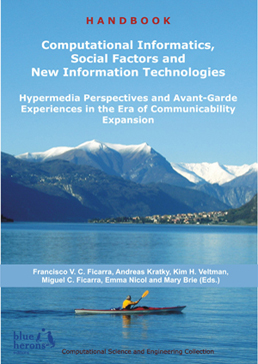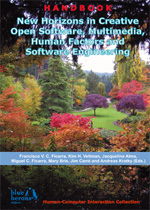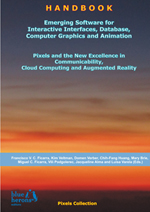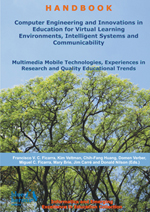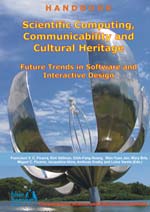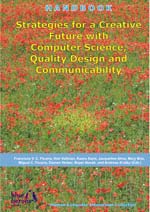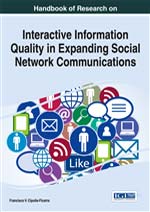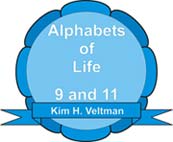Computer Engineering and Innovations in Education for Virtual Learning Environments, Intelligent Systems and Communicability: Multimedia Mobile Technologies, Experiences in Research and Quality Educational Trends
:: Informatics and Emerging Excellence in Education Collection ::
:: Revised Selected Chapters ::
Main Editor: Francisco V. C. Ficarra
Co-editors: Kim H. Veltman (Maastricht, The Netherlands), Chih-Fang Huang (Taiwan, China), Domen Verber (Maribor, Slovenia), Miguel C. Ficarra (Italy and Spain), Mary Brie (La Valletta, Malta), Jim Carré (Willemstad, Curaçao), and Donald Nilson (Oslo, Norway)
Editorial Assistant: Luisa Varela (Perpignan, France)
Book Details
• ISBN: 978-88-96471-14-2 :: DOI: 10.978.8896471/142
• Publisher: Blue Herons Editions
• Location: Italy (Bg)
• Subjects: Higher Education, Collaborative Learning, Teaching Effectiveness, E-government
• Subjects: Bioengineering, Spreadsheet Visualization, Informational Architecture, Journalism
• Subjects: Ubiquitous Learning Technologies, Human Factors, Communicability, Ontology
• Subjects: Interface Design, ICT, Agent Technology, PEC, Semiotics, Educational Research
• Subjects: User-Centred Design, HCI, Satisfaction Survey, Pedagogical Competences, RFID
• Subjects: Teaching Effectiveness, Informatics, MCL Algorithm, Biotechnology, Heuristics
• Copyright: 2012
• Collection: Informatics and Emerging Excellence in Education
• Series volume: I
• Publication date: December, 2012
• Binding: Paperback
• Grade level: General
• Language: English
• Illustrations: Yes
• Colour: Yes
• Pages: 167
• Dimensions: 11.41x8.26x0.47 in. 1.19 lbs. :: 290x210x12 mm. 543 gr.
Preface
There’s heads with books stuffed chock-a-block, very breed and brand and style, though I’m not expert in such mysteries, I’ve picked up enough to teach me this: That better than learning no-end of things is to know a few things worth while –Martín Fierro.
José Hernández (1834 – 1886)
Since the genesis of the democratization of the computer hardware and software came about in 1980 the human being has been unwittingly the apex in which a series of changes in the daily life took place, regardless of his/her financial resources or the geographical place where they are.
Currently in some college computer science teaching centres the use of the expression “educational excellence” has been intensified. These two words may really represent a high level or rather simply be a commercial or marketing catchphrase to attract the attention of future students in the context of the new technologies. However, in order to reach that educational excellence inside the Information and Communications Technolgies and in particular in computer science and multimedia, it is necessary to count on a series of prerequisites which go beyond the aspect of putting the latest technologies in the commercial market at the disposal of the students. In this sense there are many examples where the creative and original developments, many times without any kind of economic, public or private subsidies, surpass the educational excellence which the campaigns of educational marketing sell in the on-line and off-line supports.
One of the terms more frequently used in the educational marketing for the design of interactive systems is creativity. However, when we analyze it we realize that creativity is in the advertisement to recruit potential students –or clients, as they are called in some public, private, mixed or hybrid academic environments– for specialization courses, continuous training, masters, etc. That is, it shines because of its absence in the educational programs or in the contents of the interactive systems made as practices for example.
The hardware that constantly evolves ahead of the software requires computer science, high quality systems, in the last possible time and with reduced costs. Besides, the breathtakingly fast process of inclusion of users, experts or not, in a myriad of issues of systems engineering, software, etc., such as cloud computing, makes that communicability must be present in each one of the categories of design of the systems or interactive applications. We understand under interactive design in the current handbook the following set of categories: presentation or layout, content, navigation, structure, compatibility or connectivity and panchronic. Each one of them interrelated. Now the current problem inside the context of the new technologies is to find real professionals who represent the intersection of the formal and factual sciences, since we are in the era of the expansion of communicability. We have overcome the stage of the usability of the systems of the 90s (but for some exceptions stemming from micro computing, for instance).
In our days every user is practically an editor of interactive content (one of the main goals of the evolution from hypertext to hypermedia) with a 100% autonomy. That is, to give shape to a human capital in keeping with the new technological challenges of the 21st century but with a correct behavior in the online community. In this sense, the human and social factors may remarkably slow down the harmonic advance between the users and their interaction with the new technologies.
In other words, an increase of the pressure groups is detected, which is negative not only for the freedom of information but also for the process of the democratization of the diffusion of scientific knowledge. Regrettably sometimes education, scientific research, the technological transfer from the university towards the industry (or vice versa) etc., are secondary in the face of an opaque editorial business without professional ethics, that is, totally opposite to the main principles of the epistemology of the sciences. In short, our field of study encompasses the following issues that are presently enumerated in alphabetical order. Besides, we will try to indicate the main lines of action and tendency for an excellence in the communicability for all.
The current handbook is intended to be a union of all those people who daily work and/or develop new technologies, interactive multimedia systems, digital contents, etc., using unprecedented and innovative aspects in the teaching and learning processes, inside and outside the classrooms. That is, an intersection of computer science, telecommunications, educational sciences, pedagogy, social psychology, among other fields of the formal and factual sciences. Simultaneously, another of the main goals is to present those scientific works which are a compass in time, for all the agents who participate in the educational process and irrespective of the technological resources which are at their disposal.
Some of the works that make up the current compendium have been presented orally by their authors in the following international workshop in Venice, Italy: HCITOCH 2012 –Third International Workshop on Human-Computer Interaction, Tourism and Cultural Heritage: Strategies for a Creative Future with Computer Science, Quality Design and Communicability, and international conference in Huerta Grande (Córdoba), Argentina: ADNTIIC 2012 –Third International Conference on Advances in New Technologies, Interactive Interfaces and Communicability: Design, E-commerce, E-learning, E-health, E-tourism, Web 2.0 and Web 3.0
The innovation and originality of those proposals has been the reason for which the authors have been invited to enlarge their works submitting again the new versions to an assessment process of said works by the members of the scientific committee. Consequently, these are works that have gone satisfactorily through a double process of international selection. In the next section a short introductory presentation of the research works that make up the current compendium is given:
The excellent quality of the content as well as the acuteness in the research makes the prologue “Towards a Meaningful Web of Knowledge” signed Kim Henry Veltman an obligatory reading for all those who want to know in a magisterial way the past, present and very specially whereto we are going with the knowledge in the web, in the current era of expansion of communicability. This intense and entertaining work of research consists of the following sections: Early Internet Pledges, Conceptual WWW Pledges, Science versus Human Sciences, New Organization of Information and Knowledge, Challenges, Knowledge, Information and Data, Integration of Strands, among others. Each one of them shows an original way of knowing the evolution of the web. Besides, it entails a splendid 360 degrees vision in scientific observation to approach the central issue and the secondary issues that the author has set himself at the moment of carrying out his research. The examples enrich each one of the different sections and clarify a myriad of notions which currently are unknown by millions of users of interactive systems of the last generation. It is necessary to point out that these examples, included those treated in the annexes, may be sources for future research of the coming generations.
In the chapter “College Student Perceptions of Teaching and Learning Environment” whose authors are María Isabel Dorta-González and Pablo Dorta-González it can be seen how the use of statistics is very positive for education whether from the point of view of those who teach the lessons (professors), their recipients (students) or the context in which said lessons develop. This interesting text constitutes a kind of compass for all those who want to measure the quality of teaching. Each one of the different sections, such as Centrality Measures in Social Networks, Eigenfactor Centrality Weighted Rating, Empirical Application, etc. show the importance of mathematics in the heuristic evaluation of the quality of a system. In this case the empirical application data by the Department of Mathematics of the University of California, Berkeley. In the study the accurate bidirectional interrelations among the following main subjects can be appreciated: statistics, mathematics, centrality in social networks, higher education, satisfaction survey, student evaluation of teaching, and teaching effectiveness.
The authors of the chapter “Enhancing Education: Ubiquitous Learning Technologies for Classroom Based Collaborative Tasks” are Gemma Savagar, Alex Stedmon, and Tim Brailsford. They have examined one of the aspects of great interest currently for the educational context such as the use of ubiquitous mobile technologies. The work presents a review of all those didactic resources linked to the technology of the time to boost or foster learning in the classrooms. In parallel they have developed in an intensive way a series of tests with the goal of verifying the impact of ubiquitous mobile technologies in the classrooms. An interesting summed-up historic vision has been included by the authors. Said vision can quickly place the reader in the evolution of the technologies that have been used with didactical purposes in the classrooms of high schools and universities to mention two examples in the last decades. There is also an interesting bibliography which may be looked up by those interested in widening the concepts that the authors present in the chapter.
In the research called “Re-thinking Teaching Human-Computer Interaction” its authors Damjan Obal and Domen Verber focus on the human-computer interaction from the point of view of education. The authors make a study on a methodology called “double diamond” which is complemented with an experimental paradigm. The experiment carried out by university students from Media Communication resorts to techniques and methods stemming from heuristic evaluation. The study starts with the genesis of the project, highlighting the cultural aspects of the city where it is developed. The state of the art of the topics that are approached along the text are well related to the suggested methodology, for instance. Each one of the presented issues are matched with a recent bibliography, adding an extra value to the work. The conclusions allow to detect all the theoretical and practical activities made by their authors, collaborators, participants in the heuristic evaluations, etc. as well as the future lines of research.
In the chapter “Spreadsheet Visualization using MCL Algorithm” its authors Yirsaw Ayalew and Bennett Kankuzi reveal a tool that uses and increases the functionality of Microsoft Excel from the point of view of programming and resorting to the Markov Clustering (MCL) algorithm. The spreadsheet visualization approach developed in this work supports the understanding of the spreadsheet by extracting the hidden data dependency graph presented to the user in the form of cell clusters based on the MCL. The positive results they have obtained with real users of the prototype tools make apparent that the users have positively assessed the advantages and qualities of the practical part of the current proposal which is developed in the following way: A detailed discussion of the prototype tool is presented, a discussion on the results and associated issues. The figures that accompany the text serve to demonstrate the potential of the current proposal with a worldwide spread application such as Microsoft Excel.
The authors Elena B. Durán, Margarita M. Álvarez, Silvina I. Únzaga in their research “Ontology and Software Agents to Assist Ubiquitous Learning” focus on the ubiquitous learning (u-learning). The development of u-learning applications requires considering the user characteristics and necessities and the complex set with multiple ways of mobility, diverse mobile technology, diversity of carriers, and also, the diversity of learning situations that might happen. Along the text, there is a comprehensive description of the principles about the agent technology and the semantic web with ontologies offer efficient tools to manage this problem. In this chapter, both technologies, software agents and ontology are presented. Besides, the architecture of a web system is introduced. In other words, it consist of a set of software agents responsible for the maintenance of required ontologies to personalize various services of an ubiquitous learning environment.
“E-government Services: Italian Standard Certified Electronic Mail” is the title of the work developed by Marina Buzzi, Francesco Gennai, Claudio Petrucci, and Alessandro Vinciarelli. As it is indicated in the title, it is a service of the public administration to speed up the red tape with the citizens of a community for example by way of a system of standard certified electronic mail. In the research work describes an interrelation of computer science knowledge, systems, telecommunications, such as the safety of information, data distribution or certified information in the different types of wired networks and unwired, etc. Besides, the system has been developed bearing in mind the quality guidelines of the software, the classical usability principles, the interactive design, etc. so that the inexperienced users in the use of computers did not have big complications, for instance. The chapter is divided basically into three main areas: technical rules, interoperability test with the goal of verifying the quality of the service and the international diffusion of the results reached. Finally, it is interesting how the authors have confirmed that the use of standardization of interactive systems allows great achievements among users and sectors of the public administration for example through the certified digital mail.
The authors Andreas Kratky and Daphne Ho in their work “Communicating Immigrant History and Identity Through Food-Objects” introduce all the details of an interactive installation oriented at culture. The work starts with an excellent state of the art about the subject of acculturation processes and the importance of digital media. The developed project proposes a set of strategies used to gather information among the generations of a same culture and generate static and dynamic interactive material. The obtained results have been mirrored in some interactive installations where the history of daily life objects related to food constitute the link between the users and the interactive contents. The cultures to which such installations refer are the Chinese and the American. Through an interesting collection of examples a perfect amalgam between new technologies and avant-garde perspectives can be seen in order to approach complex issues such as the cultural heritage through the generations inside a Chinese –American family.
Liliana Mâţă is the author of the chapter “Social Media Tools for Development of Pedagogical Competences of Language Teachers from Initial Training Programs.” The work is divided into two main parts: The first, theoretical and focused on the teacher education and social media and the second methodological where the students play a central role. They have been evaluated in the use of social media tools from the point of view of pedagogical competences. The author makes a detailed analysis from the theoretical point of view at the moment of considering the main variables for social media in language teacher education in international and national context and very specially those competences which theoretically are developed with the integration of the new technologies. Along the pages one can see didactically the motivations why the author claims that the field of social media technologies in language teacher training is a constant source for future research. These thoroughly highlighted motivations by Liliana Mâţă can be confirmed simultaneously by the results obtained in the heuristic evaluation carried out with the students at the moment of interacting with the new technologies, in the social networks, for instance.
Ricardo A. M. Taborda presents in an orderly and with an excellent didactic level a rhetoric question “What is Bioengineering? The Many Meaning Behind a Name.” The content of the chapter starts with a study of the state of the art and the motivations of the current research. It shows some central axis of research carried out by the author: the historic development of the many words associated with the concept, the typical activities of a modern biomedical engineer are related to what is being offered in education, etc. The content of the proposal is very well organized and expresses the main aspects dedicated to the professional and scientific societies associated with Bioengineering. Finally, a small section dedicated to future research. In few words, it is an excellent beacon in the context of the bioengineering over the past, present and future of the new professionals.
The rhetoric question “Excellence in the Education of New Information and Communication Technnologies?” made by the author is the starting point of a diachronic-synchronic analysis of the academic reality in the universities of Southern Europe, especially in the multimedia educational environment, human-computer interaction, with an extension towards the commercial and industrial sector through the transfer of knowledge. Using a new language for the timeless description of true events in the academic field, the causes can be easily detected of the current deviations which prevent educational excellence, as well as the certainties and uncertainties of the future in the short, middle and long-run. Besides, a first set is presented of techniques that have been developed starting from the information published in the scientific and commercial news in digital and/or analog support. Part of this information are the visual examples which go with the text and serve to establish a map of those places where the educational excellence of Southern Europe is equal to zero.
Francisco V. C. Ficarra
Tenerife, Spain (December 2012)
Partial Content On-line (pdf format)
• Front Cover (here)
• Preface :: Acknowledgment (here)
• Chapters :: Final Remarks :: Author Index :: Keywords Index :: References ... (here)
• Back Cover (here)
Additonal Handook Info
• Only paper copy – no digital book on-line and/or off-line –
• Special Price € 95 (expedition cost not included) ... e-Commerce :: Info Form
Welcome to Blue Herons Editions!
The origin of this publishing project is to be found in the Canadian lands, where nature presents itself generous in many places of its wide geography. More...
Education, Communicability, Design, Computer Science, HCI, Computer Graphics and Computer Animation:
We focus on education and new technologies with 32 years long experience. More...
Literature and Journalism:
Intersection between universal literature, local new journalism (true stories), sociology and legal immunity. Two collections:
- Casoncelli Bergamaschi
It is a typical bergamasque dough filled with meat, similar to the raviolis. More...
- Menjar Blanc & Black
It is a typical sweet of the Catalan coast and the Balearic Islands. More...
Others New Releases:
See all others new releases in books, CD, DVD, etc. More ...
Call for Papers: ADNTIIC 2015 :: HCITOCH 2015 :: SETECEC 2015 :: HIASCIT 2015 :: CCGIDIS 2015 :: IPCTIIC 2015 | HCITISI 2015 :: MSIVISM 2015 :: RDINIDR 2015


